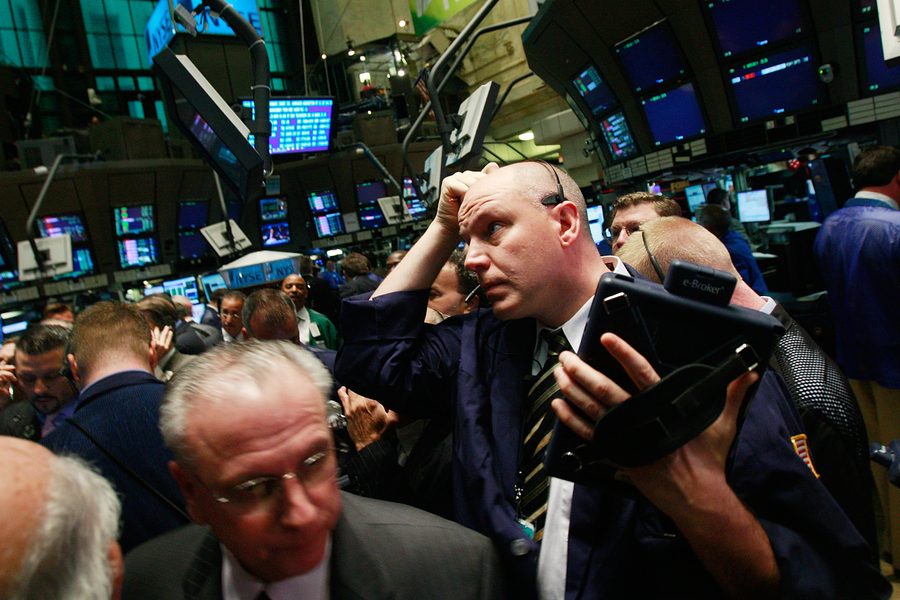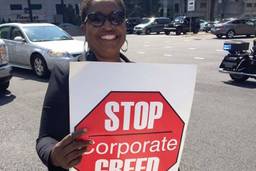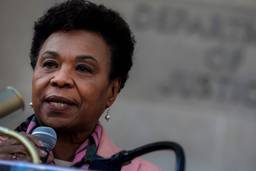The Stock Market Crash Reveals the Rot at the Core of Our Economic System
Matthew Cunningham-Cook

We just saw the steepest stock market decline in six and half years, and the largest one-day point decline in the history of the Dow Jones Industrial Average. Last week saw the worst week on Wall Street in two years. The precipitous fall follows the recent so-called “Trump rally,” where stock market values inched to their highest level since World War II.
While this downturn may not spell an immediate crisis for capitalism, it does further reveal the rot at the core of the system. The largest financial firms can profit from sudden fluctuations in the market — while ordinary investors such as those with pension funds and 401(k)s are left holding the bag. This volatility in the market has allowed for more Wall Street ticks to suck at the hog of the roughly $27 trillion in retirement assets held by Americans.
There are a few principles that guide how traders and speculators on Wall Street operate: Buy low and sell high. Liquidity in the market generates profits. And use information to your advantage. Within this framework, a small group of powerful banks dominates Wall Street trading, including JP Morgan, Goldman Sachs and Bank of America Merrill Lynch.
Many of these powerful financial institutions have been betting that volatility will rise. The Wall Street Journal reported in April that “banks would suddenly be sitting on huge profits from their volatility insurance” were volatility to increase. Low volatility in the stock market has hurt the revenue of trading desks such as those at Goldman Sachs by reducing opportunities to exploit spreads in prices. The largest banks have discretionary control over hundreds of billions of dollars in assets that, through selective buying and selling, can create added volatility in the market.
Goldman, in particular, has a long history of benefiting handsomely from rises in volatility. During the 2008 financial crisis, Goldman’s former Chairman Hank Paulson served as Treasury Secretary while another former Chairman, Stephen Friedman, served as head of the New York Fed — Goldman’s primary regulator. Goldman’s former chief lobbyist in London, Joshua Bolten, was White House chief of staff, and another Goldman vet, Neel Kashkari, was a top deputy to Paulson.
At the end of 2006, Goldman began to short the residential mortgage-backed securities market (RMBS). The eventual collapse of RMBS helped trigger the financial crisis in 2008.
Nearly every bank with exposure to the collapse in the RMBS market was either bailed out by the government or put into an orderly receivership. The lone exception was the investment bank that was likely the most exposed to the subprime market, Lehman Brothers. Lehman’s Chapter 11 bankruptcy filing meant that there would be no aid from the government, and investors holding Lehman RMBS could expect to get just pennies on the dollar.
Every other major bank was deemed by Paulson, Friedman, Bolten and Kashkari to be Too Big To Fail because of the mortgage crisis, except for Lehman, whose collapse would trigger massive profits for Goldman. While the pension funds that had purchased Lehman securities lost billions, Goldman made out swimmingly.
Then there’s LIBOR, or the London Interbank Offered Rate, which was tied to the value of $800 trillion in securities worldwide. In 2012, nearly all of the world’s major banks were found to have manipulated LIBOR by artificially distorting the data they submitted to set the rate. Andrew Lo, a professor of finance at MIT, said in 2012 that the scandal “dwarfs by orders of magnitude any financial scam in the history of markets.”
These gambits demonstrate how concentrated power in financial markets allows for the largest institutions to manipulate these markets for their benefit. And under President Trump, even the most basic levels of securities law enforcement have decreased dramatically. Law360 reported in November 2017 that enforcement activity had “plunged” since the Trump administration began.
In January, Trump installed Robert Khuzami, a former Deutsche Bank general counsel, as the number-two U.S. Attorney for the Southern District of New York, which commonly leads securities prosecutions with the Securities and Exchange Commission. And Goldman alum Steven Mnuchin is currently serving as U.S. treasury secretary. This regulatory rollback, overseen by individuals with strong ties to the financial industry, allows bad actors in the market to ensure that they can operate unscathed.
When the markets fall precipitously, as recently happened, it’s generally not the “invisible hand” at work. Every bet has a winner and a loser, and in the casino of Wall Street, the house always wins. The up-and-down jumps of the market benefit those with inside or privileged information. And on the other side are the millions of ordinary investors with little understanding of the intricacies of how the market actually works, and with little control over how their wealth is actually invested.
In July, Simon Derrick of BNY Mellon complained to CNBC that the “lack of volatility leads to a lack of trading profits.” And the Wall Street Journal reported Tuesday in an article entitled “Banks Cheer Return of Wild Markets” that banks “have blamed placid markets for lackluster returns in their big trading operations” but that “they’re cheering the big market swings, seeing hope for a boost in fees that dropped off a cliff last year.” The paper also quoted a financier saying “[a]nything that brings back volatility would be good.”
Besides the big banks, another prominent beneficiary of the rise in volatility is billionaire Vincent Viola’s Virtu Financial, a high-frequency trading firm that handles 20 percent of all equity trades in the U.S. stock market every day — that saw its profits plummet alongside the reduction of volatility in the markets. After this past week, Virtu now “rides high” with its share price jumping 40 percent in two days. Viola, the founder and “Chairman Emeritus” of Virtu, has significant ties to Donald Trump, who briefly nominated Viola as Secretary of the Army in 2017.
While it’s impossible to prove that the level of manipulation that occurred with LIBOR and the 2008 financial crisis is happening now, there is motive and opportunity: Wall Street’s largest trading desks were negatively hit by low volatility, and the same banks and hedge funds have control over hundreds of billions of dollars that can influence price swings in the markets. And for their bets on price swings in a volatile market to pay off, Wall Street has to have someone on the other side of that bet: the dumb money of pension, 401(k)s, and mutual funds. The rise of high-frequency trading firms like Virtu come at the expense of everyone else.
So what needs to happen to protect these ordinary investors from such fluctuations? In a February In These Times cover story, Liza Featherstone and Doug Henwood lay out one smart solution — a massive expansion of Social Security so that people aren’t dependent on deeply corroded markets for their savings and retirement.
Another good idea would be to eliminate the tax exemption for municipal bonds, and compelling pension funds to invest in municipal bonds instead of Wall Street. This would end a huge tax shelter for the rich, while returning public pension funds to the investment strategies that worked well for them through the end of the 1960s.
A revived Glass-Steagall Act to separate commercial and investment banking would also help to stamp out market manipulation by reining in the power of banks like Goldman and JP Morgan. But for these things to happen, there needs to be a more adversarial public attitude towards high finance. The stock market isn’t guided by an invisible hand: There are real people behind it and profiting from it — and it isn’t you.







